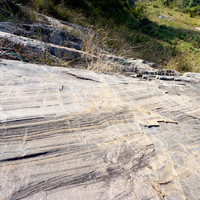10 Oldest Earth Rocks That Matter
Posted by The Science Mall Team on 7th Jan 2024
Why the 10 Oldest Significant Earth Rocks Matter
Rocks are the building blocks of our planet, each telling a unique story about Earth's history. From their chemical composition to their age, these rocks hold invaluable information that helps us understand our planet's geological past. This article explores ten ancient rocks from pivotal locations that reveal insights into Earth's formation and paleogeography. They are also highly valued in museum collections and rock and mineral displays.
1. Jack Hills Zircons
Found in Western Australia's Jack Hills region, the Jack Hills zircons are tiny minerals dating back 4.4 billion years. They are the oldest known minerals on Earth. Radiometric dating of these zircons has provided critical information about Earth's early formation. The presence of water traces in these zircons suggests that liquid water may have existed on Earth much earlier than previously believed.
2. Nuvvuagittuq Greenstone Belt
Located in Quebec, Canada, the Nuvvuagittuq Greenstone Belt is one of Earth's oldest known rock formations, dating back approximately 4.3 billion years. This site contains ancient volcanic rocks, offering essential insights into the atmosphere and environmental conditions present during Earth’s early development.
3. Idiwhaa Tonalitic Gneiss (Acasta Gneiss)
The Acasta Gneiss, found in Canada’s Northwest Territories, is one of Earth's oldest exposed rock formations, dating back around 4.02 billion years. This ancient rock provides valuable information about the conditions and compositions of Earth’s early crust.
4. Isua Greenstone Belt
The Isua Greenstone Belt in Greenland, estimated to be around 3.7 billion years old, holds some of Earth's oldest sedimentary rocks. These ancient rocks have provided scientists with insights into the early Earth's climate and ocean conditions.
5. Akilia Island
Akilia, a small island off Greenland's coast, features an ancient rock formation around 3.7 billion years old. Some evidence suggests it might contain microscopic fossilized structures, possibly some of Earth's earliest life forms. Verification of this finding would make Akilia an essential site in geological collections.
6. Snowball Earth
The "Snowball Earth" hypothesis suggests that at certain points in history, our planet was completely ice-covered. Scientists believe there were two to three such events, around 717 million years ago, with conditions ranging from partial to complete glaciation. These extreme climatic events likely influenced the evolution of life on Earth.
7. Meteorite Spherule Bed Marble Bar, Western Australia
The Marble Bar region in Western Australia contains ancient spherule beds from meteorite impacts dating back about 3.5 billion years. These small spheres provide valuable data on the Earth’s early atmosphere and the frequency of meteorite impacts during that period.
8. Meteorite Spherule Bed Barberton Greenstone Belt, South Africa
The Barberton Greenstone Belt in South Africa, estimated to be around 3.5 billion years old, contains additional meteorite impact spherule beds, offering further evidence of ancient meteorite impacts.
9. Eriksson's Lithified Dune, South Africa
Eriksson's lithified dune in South Africa, approximately 3.2 billion years old, is a rock formation that has undergone compression and hardening over time. The layered sediments in this ancient dune provide remarkable insights into Earth’s climate and atmospheric history during that era.
10. Komatiite from Barberton Greenstone Belt, South Africa
Komatiite is an ultramafic igneous rock dating back about 3.5 billion years, found in South Africa’s Barberton Greenstone Belt. Its high magnesium and nickel levels offer a glimpse into Earth’s early geochemical and atmospheric conditions.
Summary
These ten ancient rocks, from 4.4 Ga are essential to understanding Earth's historical geology, paleogeography, and the geologic time scale. Each rock holds a unique story of Earth's formation and evolution, offering scientists valuable data on our planet's changing conditions over billions of years. These rocks are not only significant for geological studies but also serve as timeless museum pieces for rock and mineral collections worldwide.

